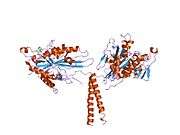KIF5C
Kinesin heavy chain isoform 5C is a protein that in humans is encoded by the KIF5C gene.[5][6]
References
- 1 2 3 ENSG00000276734 GRCh38: Ensembl release 89: ENSG00000168280, ENSG00000276734 - Ensembl, May 2017
- 1 2 3 GRCm38: Ensembl release 89: ENSMUSG00000026764 - Ensembl, May 2017
- ↑ "Human PubMed Reference:".
- ↑ "Mouse PubMed Reference:".
- ↑ Niclas J, Navone F, Hom-Booher N, Vale RD (Jun 1994). "Cloning and localization of a conventional kinesin motor expressed exclusively in neurons". Neuron. 12 (5): 1059–72. doi:10.1016/0896-6273(94)90314-X. PMID 7514426.
- ↑ "Entrez Gene: KIF5C kinesin family member 5C".
Further reading
- Engelender S, Sharp AH, Colomer V, et al. (1998). "Huntingtin-associated protein 1 (HAP1) interacts with the p150Glued subunit of dynactin". Hum. Mol. Genet. 6 (13): 2205–12. doi:10.1093/hmg/6.13.2205. PMID 9361024.
- Nagase T, Ishikawa K, Miyajima N, et al. (1998). "Prediction of the coding sequences of unidentified human genes. IX. The complete sequences of 100 new cDNA clones from brain which can code for large proteins in vitro". DNA Res. 5 (1): 31–9. doi:10.1093/dnares/5.1.31. PMID 9628581.
- Xia Ch; Rahman A; Yang Z; Goldstein LS (1998). "Chromosomal localization reveals three kinesin heavy chain genes in mouse". Genomics. 52 (2): 209–13. doi:10.1006/geno.1998.5427. PMID 9782088.
- Junco A, Bhullar B, Tarnasky HA, van der Hoorn FA (2001). "Kinesin light-chain KLC3 expression in testis is restricted to spermatids". Biol. Reprod. 64 (5): 1320–30. doi:10.1095/biolreprod64.5.1320. PMC 3161965. PMID 11319135.
- Strausberg RL, Feingold EA, Grouse LH, et al. (2003). "Generation and initial analysis of more than 15,000 full-length human and mouse cDNA sequences". Proc. Natl. Acad. Sci. U.S.A. 99 (26): 16899–903. doi:10.1073/pnas.242603899. PMC 139241. PMID 12477932.
- Brickley K, Smith MJ, Beck M, Stephenson FA (2005). "GRIF-1 and OIP106, members of a novel gene family of coiled-coil domain proteins: association in vivo and in vitro with kinesin". J. Biol. Chem. 280 (15): 14723–32. doi:10.1074/jbc.M409095200. PMID 15644324.
- Smith MJ, Pozo K, Brickley K, Stephenson FA (2006). "Mapping the GRIF-1 binding domain of the kinesin, KIF5C, substantiates a role for GRIF-1 as an adaptor protein in the anterograde trafficking of cargoes". J. Biol. Chem. 281 (37): 27216–28. doi:10.1074/jbc.M600522200. PMID 16835241.
- Ewing RM, Chu P, Elisma F, et al. (2007). "Large-scale mapping of human protein-protein interactions by mass spectrometry". Mol. Syst. Biol. 3 (1): 89. doi:10.1038/msb4100134. PMC 1847948. PMID 17353931.
This article is issued from
Wikipedia.
The text is licensed under Creative Commons - Attribution - Sharealike.
Additional terms may apply for the media files.






